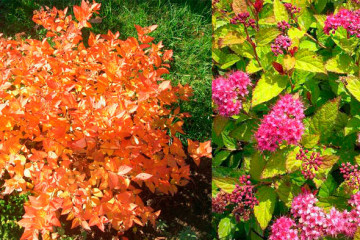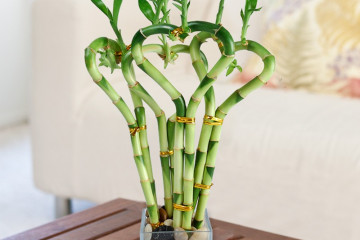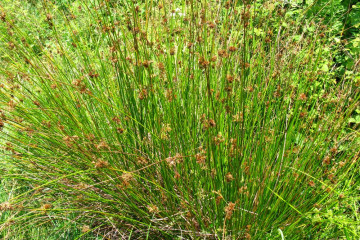Japanese fatsia - home care
Content:
Japanese Fatsia (Fatsia japonica) is popular with indoor plant lovers, as it suits almost any interior. It multiplies easily, and with proper care, a beautiful bush with a gorgeous crown grows. The features of this home flower, the most interesting varieties, the rules for caring for an apartment are described in detail below.
What does Japanese fatsia look like, which family does it belong to
Japanese Fatsia belongs to the Fatsia genus. Family - Araliaceae, which includes shrub and liana-like plants. Differs in large green leaves and a significant length of the bush.
Outwardly, the plant is very similar to a chestnut. Sometimes at home in Japan it is called so: "home chestnut", "Japanese chestnut". For this name, the plant owes its beautiful leaves. They very much resemble chestnuts, only much smaller in size.
The petioles are rather long. They have large leaves, reaching almost 30 cm in diameter. The plate itself is not entirely solid. It consists of 5 or 8 and sometimes 9 blades. It is no coincidence that fatsia from Japanese means "eight", because that is how many blades a leaf of a plant most often has. In general, the leaf blade resembles an ellipse or heart.
The color characteristics are very different. There are both monochrome forms and variegated variants. Along the edges there may be notches and notches of the most bizarre and varied shapes.
In terms of size, it is more of a shrub. But the stem is quite thin, although it reaches 1 meter (the maximum recorded is 2 meters). In the fatsia plant, the flower does not have the same attractiveness as the leaves. Inflorescences in the form of umbrellas of inconspicuous whitish or somewhat greenish flowers are usually cut off by breeders even before blooming.
If the inflorescences are left, after a certain time in their place you can find bluish-blue, even purple berries. The seeds do not always ripen in them, so there is no need and sense to leave them for the purpose of reproduction.
Common varieties
Japanese fatsia is quite varied. There are about a dozen varieties that are grown for decorative purposes in indoor conditions.
- First of all, the Fittshedera Lice variety is distinguished. The plant is remarkable in that it is an interesting hybrid of common ivy and shrub. As a result, the owner can get a five-meter liana. Its advantageous difference is that it is evergreen, the color of the leaves can be the most bizarre and interesting. The flowers are small and inconspicuous.
- Fatsia of the Moseri variety (Mazeri) grows very slowly. The bush itself is undersized, but the crown of leaves is very dense and attractive. The plant is quite capricious, as it requires compliance with a constant temperature regime and humidity. It is difficult for many to maintain optimal microclimate parameters for Mazeri Fatsia.
- The Samurai variety, on the other hand, is a very tall plant. It reaches 1.5 meters in height. The leaves look very attractive due to their special star-shaped shape and characteristic shine.
- Fatsia variety Spider Web, with proper care in a comfortable home environment, looks very unusual. The foliage has a mysterious whitish bloom that resembles a cobweb. The crown itself is spherical, rather large. In some cases it reaches half a meter in diameter.
- Fatsia Variegata is interesting for its leaves, which are arranged spirally relative to the stem. Their color also attracts attention - it is rich green with delicate matte cream spots, stains. The spots are white along the edges.
Japanese fatsia - home care
It would be untrue to write that home care for such a plant as fatsia is simple. It is necessary to observe not only the temperature regime, but also the optimal air humidity. Otherwise, various diseases await Fatsia.
- Temperature
Warm atmosphere is considered best for Japanese Fatsia. According to the rules of care, the average temperature that should be adhered to at home should be around 19 degrees.
The temperature should definitely not exceed +21 and be below +17 degrees, otherwise the fatsia grows worse, quickly turns yellow.
- Lighting
In indoor conditions, the flower should be in a somewhat shaded place. This is due to the fact that fatsia does not tolerate exposure to direct sunlight.
The best way out is to orient the flower to the north side. On the south windows, there will be an additional need to shade the fatsia.
- Watering
For the correct observance of the water regime, it is necessary to assess the topsoil. As soon as it starts to dry, you need to water the plant.
An indoor flower does not tolerate excessive moisture well. Destructive for fatsia and drying out. Therefore, drainage holes are needed, but deep trays are not.
- Spraying
To maintain proper care for such a capricious houseplant as fatsia, wiping the sheets with a damp sponge is recommended.
- Humidity
Given that all aralia plants are native to the tropics and subtropics, humidity must be maintained at a high level. Therefore, it is very important to spray the plant, as well as periodically wipe the leaves with warm water. It is also necessary for the prevention of various diseases.
- Priming
The ideal mixture for fatsias contains earth, peat and sand. They must be present in equal amounts. The land is sod or leafy.
Pay attention to the acidity index - it should not be lower than 5.0 and not higher than 7.0 pH.
- Top dressing
The plant reacts gratefully to fertilizers. The main thing is not to overdo it. For example, in winter, feeding is not needed at all. But in the summer, organic fertilizers can be added once a week.
- Features of care in winter, dormant period
In winter, the plant should be looked after more carefully. Additional lighting is required using fluorescent or fluorescent lamps.
- Pruning
Pinching the tops of the shoots helps the plant to branch. This preserves the necessary beautiful shape of the crown of the shrub.
The plant tolerates pinching. Therefore, pruning can be done several times a year.
How the indoor flower Fatsia japonica reproduces
There are three ways. Each of them is convenient in its own way and has disadvantages and advantages.
Germinating seeds
The main condition for the implementation of this method of reproduction is the integrity and safety of the seeds. They must have good germination.
First you need to choose the right substrate. To do this, take part of the soil, part of the sand and part of the turf. This will be the nutrient substrate for fatsia. It must be placed in containers and well moistened.
The seeds are taken large, whole. They are sown sparsely, and then covered with a thin layer of leafy soil. The containers are left in a warm place, covered with foil (glass can be used).
When the plants rise and 2-3 leaves appear on them, they begin the diving process. The next step is to plant the plant separately in a pot.
Rooting cuttings
Of the vegetative propagation methods, the most common is through cuttings. The upper part of the plant is cut in the spring. The handle should still have swollen buds, preferably in the amount of 3. For speed, you can treat them with a special growth accelerator.
A mixture of peat and soil is placed in a container. You can also add some sand there. The finished cutting is strengthened in this soil, preferably 2 cm deep. The optimum temperature is +26 degrees.
When the shoot takes root, you can plant the new plant in a separate pot.
Air layering
Cultivation using the following technique is longer and more difficult. But at the same time, it is beneficial and effective.
First, you need to find two neighboring nodes closer to the top. A shallow, vertically oriented incision is made on the stem.
It needs to be wrapped in wet moss. It is better if it is moistened with phytohormones or other growth stimulants. You can fix the moss to the trunk with foil. An alternative option is cling film.
The main condition is not to let the moss dry out. After about 30-60 days, roots appear at the site of the incision. After 30 days, you can already cut the plant below the root level and replant. Thus, the fatsia plant rejuvenates.
Transfer
The ideal time to transplant fatsia is late spring or early summer. It is believed that the ideal frequency is once every 2-3 years.
With more frequent transplants, the risk of damage to the root system outweighs the need and benefit.
The need for a transplant is determined by the drainage holes. If roots have penetrated them, then it's time to transplant Japanese chestnuts.
The new container should be 5 cm larger than the previous one. A plant is placed there, which was carefully shaken off the old soil, diseased or rotten roots were cut off.
Diseases and pests
For such a capricious plant as fatsia, home care needs constant and thorough. Failure to comply may result in various illnesses and problems.
Scales quickly fall on a vulnerable plant. It is very difficult to remove parasites. Outwardly, these are brownish tubercles on the leaves, closer to the "veins". They attach to the leaf, feed on juices and infect bacteria. As a result, the leaf first becomes less elastic, then turns yellow and dries. The plant itself stops blooming, begins to hurt. If nothing is done, the Fatsia will eventually die.
Spider mites are another pest that can be found on the leaves and stems of fatsia when the air in the house is insufficiently humidified. The leaves are shrouded in white, sticky cobwebs - a sure sign of the presence of the parasite. After a while, the leaves turn yellow, dry and fall off, becoming covered with dark brown spots.
Signs and superstitions
In Old Japanese, the name of the plant means "eight". This is a reference to the number of blades on the leaf. This name of the flower has no other meaning.
At home, the Japanese are convinced that the flower protects the home from evil spirits. Today, fatsia is used in rooms where there is obviously a lot of negative energy. It helps to get rid of unpleasant, negative thoughts. If you believe the observations and beliefs, the leaves of the Japanese chestnut absorb all the negativity and all the gloomy vibes.
If the family has conflicts, frequent quarrels, scandals, Japanese Fatsia pacifies the household. She brings calmness, understanding to the house.
The Japanese chestnut is a capricious flower.But with proper care, it looks very beneficial and complements any interior solution. It is important to carry out disease prevention so that the plant does not suddenly die.




















